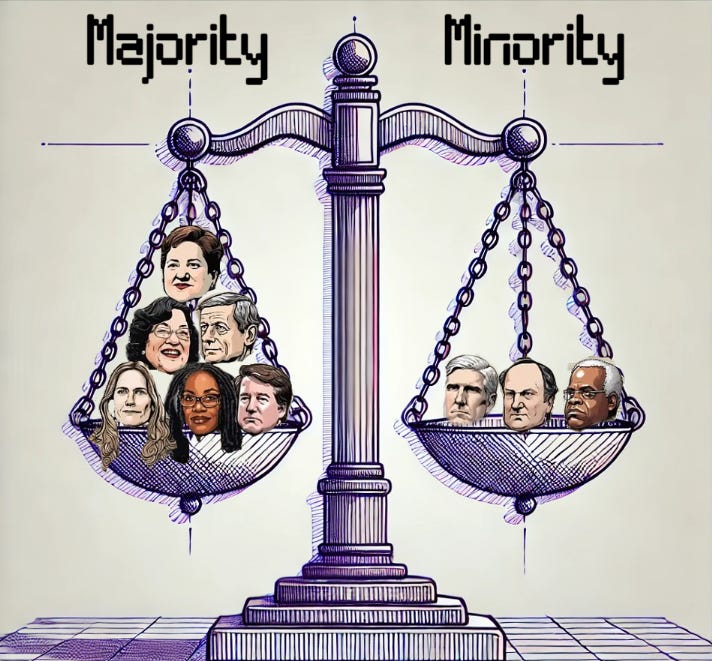LawBurst: Moody v. NetChoice Supreme Court Ruling UPDATE
SCOTUS rules to uphold free speech for now, dealing social media companies an empty victory

Background
As previously discussed in this prior post, the case of Moody v. NetChoice concerned laws passed by Texas and Florida that had limited how social media companies, like Facebook and YouTube, could moderate the content that appears on their platforms. The Florida and Texas laws (i) aimed to stop tech companies from filtering, prioritizing, and labeling content in certain ways and (ii) required them to give specific reasons for removing or changing posts. Social media companies argued that these laws violated their free speech rights by restricting how they curate user-generated posts.
The Supreme Court's Decision
The Court didn’t actually make any ruling but vacated and sent the case back to the lower courts for further review.
Majority Opinion (Roberts, Sotomayor, Kagan, Barrett, Jackson, and Kavanaugh): Justice Kagan authored the Court’s opinion. 3 liberal and 3 conservative justices joined her opinion (with Justice Jackson joining only certain parts). Reading the majority opinion, it would seem the Court ruled against government control over social media content moderation, overturning conflicting appeals court decisions. However, this isn’t a victory for social media companies; it’s really a swing and a whiff.
NetChoice, the trade group representing Facebook and Google, had brought these cases as "facial challenges." It wanted the Court to declare that the laws were generally unconstitutional for everyone (as opposed to being unconstitutional for certain people — what’s called an “as applied challenge”). A win for social media companies would not only have blocked these laws but also prevented future tech regulations.
However, since the Court chose not to decide the merits of the case and to send the cases back to the lower courts (a “remand”), the First Amendment discussions in the rulings are merely comments and observations, which are not legally binding (“dicta”). They create no precedent. Rather, the cases must be reconsidered by the lower courts and any decision was punted for another day.
The interesting takeaway from the ruling is that it offers a glimpse into the justices' perspectives on regulating social media and big tech:
Justice Kagan viewed social media regulation as akin to newspaper regulation, primarily protected by the First Amendment. Her comments focused on the “intent to suppress” in these states’ laws. However, regulating algorithmic feeds may be constitutional because it sorts content based on “a user’s expressed interests and past activities.”
Justice Jackson avoided weighing in on the First Amendment, theoretical debate, which might indicate a less tech-friendly position.
Justice Barrett noted the potential implications of artificial intelligence (AI) in content moderation. She suggested that while AI might be used to implement human decisions, its outputs may not always be protected under the First Amendment (for example, if an AI model were tasked with determining what is and whether to remove hateful content). This is a point to watch in future cases. Barrett also highlighted that the free speech analysis could change depending on the “corporate structure and ownership” of some platforms — specifically, if the platform were owned by foreign entities.
Minority Opinion (Thomas, Gorsuch, and Alito): In separate, concurring opinions the minority agreed with the decision to vacate and remand the cases, but they criticized the majority for what it considered superfluous comments and opinions based on an incomplete record.
Ironically, the minority offered their own views, disagreeing that content moderation is as expressive as traditional editorial functions. They argued that the laws should be upheld to some extent to address concerns about censorship and the suppression of diverse viewpoints on social media platforms. They believed the states had legitimate interests in ensuring that all voices be heard online.
Closing Thoughts
There’s a possibility that we might see some alignment in future cases between the liberal Jackson and the conservative Barrett, Thomas, Gorsuch, and Alito. The enemy of my enemy…
There is clearly a desire to regulate social media on all sides of the aisle, but the question is how you do so without violating freedom of speech. Conservatives aim to address what they see as a liberal bias that suppresses conservative voices, while liberals focus on tackling misinformation, hate speech, and harmful content that can spread without proper moderation.
Achieving this balance is difficult. One wonders when big tech will finally face regulation, and whether regulating big tech is one of the few remaining non-partisan issues.
Resources:
https://www.thenation.com/article/society/supreme-court-netchoice-moody/
https://www.americanactionforum.org/insight/moody-v-netchoice-implications-for-speech-regulation/#:~:text=As%20the%20Court%20made%20clear,balancing%20the%20marketplace%20of%20ideas.
https://www.supremecourt.gov/opinions/23pdf/22-277_d18f.pdf
https://www.theverge.com/2024/7/1/24166388/supreme-court-ruling-moody-paxton-texas-florida-social-media-law
https://firstamendment.mtsu.edu/article/facial-challenges/
https://www.law.cornell.edu/wex/dicta
https://www.law.cornell.edu/wex/remand
https://digitalcommons.law.utulsa.edu/cgi/viewcontent.cgi?article=1364&context=tlr
https://scholarship.law.gwu.edu/cgi/viewcontent.cgi?params=/context/faculty_publications/article/1201/&path_info=Defining_Dicta_new.pdf
Images:
Image of Luchadores generated by Dall-E, Firefly, and Pixlr
Image of Scales of Justice generated by Dall-E, Firefly, DreamStudio and Pixlr
Disclaimer: This post is for general information purposes only. It does not constitute legal advice. This post reflects the current opinions of the author(s). The opinions reflected herein are subject to change without being updated.





